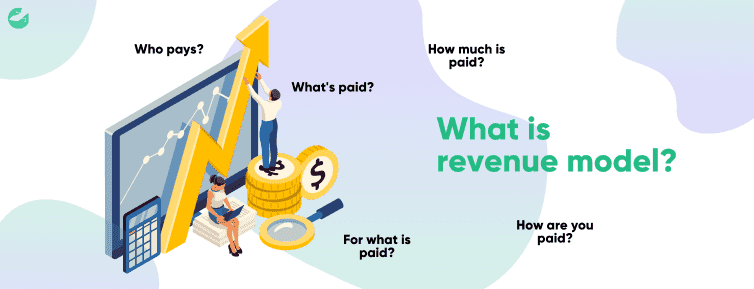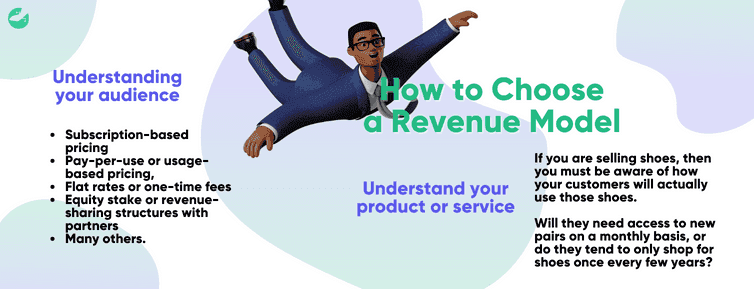revenue model
software development
+ 1 more ...
Revenue Model Types in Software Business (Explained!)
27 Jun 2023
by Tasnim, Terence Ridder & Asrul Ash
27 Jun 2023
by Tasnim, Terence Ridder & Asrul Ash
revenue model
software development
agency
Revenue Model Types in Software Business (Explained!)
Table of contents
Contact us
We will get back to you in the next 48 hours.

Choosing the right revenue model is essential for software businesses. Discover the types and how they can impact your business.
Follow Lizard Global on Facebook, Instagram, and LinkedIn.
In order to start a successful business, it is crucial to have a clear vision of how you intend to monetize the value you offer to your customers. This concept can be referred to as the revenue model of your business. But, What is the meaning of revenue model? Revenue model refers to the strategy your business applies to generate financial income. Whether your business is focused on selling physical products, providing software development services, or acting as an agency for other businesses, revenue is what keeps your train running.
Software companies are constantly developing new products and services to meet the demands of their customers. This can often involve a complex process of software development that involves many different stakeholders and specialists. However, one important factor that businesses need to consider in this process is the revenue model they will use to monetize. Depending on factors such as user demand, business goals, and compatibility with existing technologies, there are several different revenue models that a software company may choose from.
All in all, no matter which revenue model a software company chooses, it is critical that they have a solid understanding of the specific needs of their target market in order to generate revenue successfully.
Ultimately, the revenue model that a company chooses can have a major impact on its overall financial performance and product-market compatibility. As such, it is essential for businesses to carefully consider their revenue model while developing their business strategy. By doing so, they can ensure that they are maximizing their revenue potential and positioning themselves for success in today's increasingly competitive marketplace.

What is a revenue model?
A revenue model is an essential component of any business model, serving as a mechanism for earning revenue and generating profit from various sources. Simply put, a revenue model is an essential component of any business, as it dictates how a company will charge customers for its products or services and generate revenue. It involves carefully considering factors such as the customer base, cost structure, and competition to determine the most effective ways to make money.
For example, YouTube has become one of the most popular and influential platforms for content creators and viewers alike. As the largest video-sharing website, YouTube generates revenue through a variety of revenue streams, including advertising, channel memberships, live streaming, and merchandise sales. Through its robust advertising business, YouTube is able to capture vast amounts of user data that it then uses to optimize ad targeting and revenue generation.
On the other hand, whether you are designing your own revenue model from scratch or adapting one that has been established by another business, it is essential to consider a number of key factors in order to ensure optimal success. Some important considerations include choosing an appropriate pricing structure based on market demand, identifying the target customer base and tailoring a marketing strategy around those needs, and analyzing your competitors' revenue strategies in order to stay ahead of the curve. With careful planning and attention to detail, a sound revenue model can help any business succeed in both the short-term and long-term.</p>
Revenue model and revenue streams are different

As mentioned above, a revenue model is a critical component of any successful business. This model houses the revenue streams of the company and guides its strategy for managing and predicting revenue. Not only is revenue an important indicator of a company's financial health, but it can also help to determine whether or not a given strategy is working in the best interests of the business.
On the other hand, a revenue stream refers to a single source of revenue that a company generates. This revenue is often generated via different revenue models, which are sometimes divided by various customer segments.
Let us look into Spotify in this case. Spotify is a music streaming service that has been gaining popularity in recent years. At its core, Spotify is a revenue-generating software platform that provides both premium subscription and ad-supported services to users. Its revenue model can be divided into two main revenue streams: revenue from premium subscriptions, and revenue from advertisements.</p>
While revenue from subscriptions primarily comes from Spotify Premium, revenue from ads is generated through a variety of different advertising formats, including display ads, audio ads, and video ads. By delivering a high-quality listening experience to users on a wide range of devices, offering personalized recommendations and convenient music exploration features, Spotify sets itself apart from its competitors and provides a truly memorable experience to listeners.
The ads are delivered through impressions, meaning that each time an ad is shown or played on the platform it counts as one impression. All of this revenue helps to support Spotify's ongoing software development efforts and drive growth for the company overall.

Let us look into the types of revenue models

In the world of tech and digital businesses, revenue models are a fundamental aspect of success. There are many different revenue models that can be used depending on the type of product or service being offered and the industry in which it is operating. What is an example of a revenue model? Here we will pay more attention to the most common revenue models used in the software industry and online business.
Recurring Revenue Model
One of the most popular revenue models for businesses in today's digital age is the recurring revenue model, also known as the subscription revenue model. This revenue model is based on charging customers at regular intervals - often monthly or quarterly - for access to a product or service. Because businesses using this model receive payment from their customers, it is an attractive option for many companies, particularly those in fields such as software development and web design and management.
As a result, the recurring revenue model is becoming increasingly popular among companies throughout the tech industry, as well as in other sectors that require regular upkeep and maintenance. Regardless of their specific business type, companies looking to build long-term success often turn to this revenue strategy as a key element of their overall business model.
Businesses that rely on recurring revenue models often have a service-based or product-based model. Many software development companies, for example, generate revenue from ongoing software subscriptions, while subscription box services provide consumers with a steady stream of products on a monthly basis.
For example, Adobe is a leading software development company, known for its innovative and user-friendly programs in fields such as graphics and design, web development, and photography. Their revenue model is primarily based on subscriptions, which provides a steady stream of income that fuels long-term growth and supports robust flow.
Affiliate Revenue Model
Affiliate revenue models are widely used in the business world, with many successful companies relying on this monetization strategy to generate revenue. One example is Amazon, which uses affiliate links to connect users with relevant products and encourage them to make purchases.
Ticket-promoting services also use affiliate revenue models, as they promote products from various businesses and earn commissions on every purchase that is made by users. In addition, influencers may also use affiliate revenue models to advertise products from different companies and entice their followers to purchase these products through custom links.
Overall, affiliate revenue models are a key part of the digital economy, enabling businesses to connect with customers and generate revenue in new and innovative ways. Whether through software development or agency work, they continue to play an essential role in the modern economy.
Advertising Revenue Model
The advertising revenue model has been widely adopted by many types of businesses, both online and offline. This model involves selling advertising space to other companies, typically in exchange for a fee.
The space is highly sought after because it can give businesses access to large audiences, thus providing valuable visibility for their products and services.
In the world of software development, this revenue model is often used by software companies to cover their costs and offset the expenses associated with research and development. Similarly, advertising agencies utilize this revenue model to drive revenue in order to pursue new software development projects that will help clients grow their businesses.
As mentioned above, one of the most well-known businesses that use this revenue model is YouTube, which generates revenue primarily from ads displayed on its website. Other online companies like Google also use this revenue model, as do traditional outlets like newspapers and magazines. It is clear that this revenue strategy can be extremely beneficial for businesses seeking to grow their customer base and increase revenue streams.
Sales Revenue Model
The sales revenue model is a fundamental concept in business and economics. This model states that revenue is generated through the direct sale of goods or services to consumers. Whether selling products online, through retail stores, or via a third-party agency, companies that adopt this revenue model typically rely on software development and marketing strategies in order to drive sales growth.
By leveraging these key areas and staying up-to-date with trends in consumer behavior and purchasing habits, businesses can ensure their success using the sales revenue model. After all, revenue is the lifeblood of any company – so it's crucial for businesses to find a sound strategy for generating revenue effectively in order to succeed.
For example, one sales revenue model that has proven particularly successful is known as "fast fashion." Fast fashion companies like H&M are leaders in the space due to their ability to quickly and accurately predict trends in popular culture. Their competitors usually rely on a more traditional revenue model involving inventory management and software development.
However, while these revenue models have proven effective in other industries, they often lag behind when it comes to adapting to changing tastes and styles. As such, companies that focus on fast fashion are typically better able to anticipate shifts in consumer demand and consistently remain at the forefront of their market. Whether through offering fashionable clothing at an affordable price or by adopting new revenue models, the success of clothing brands consistently demonstrates how fierce competition fuels innovation within this industry.

SaaS Revenue Model
The Software as a Service (SaaS) revenue model is an increasingly popular approach to software distribution and revenue generation. Like the recurring revenue model, which has long been a staple of the software industry, SaaS sees users charged for access to software on an interval basis. However, unlike other revenue models, in which revenue generation depends primarily on attracting and retaining new customers, SaaS revenue models focus more specifically on customer retention.
With this in mind, businesses that use SaaS revenue models are typically focused on optimizing their software development processes to improve product quality and user experience. They may also work with marketing or agency partners to create innovative and effective outreach strategies that drive user engagement and loyalty.
Some well-known companies that use this revenue model include video conferencing tool Zoom, communication platform Slack, and Adobe Suite. By building robust software solutions that are easy to use and integrate with other systems and tools, these businesses have been able to achieve tremendous growth and establish themselves in the industry.
Pay-Per-Use (PPU)
This payment model allows companies to charge customers based on how much they use their product or service, rather than forcing them to purchase a subscription or one-time fee upfront. One of the most well-known examples of pay-per-use is the software development agency Apple iCloud, which allows users to rent storage space according to their needs.
Other companies have also found success with this revenue model, recognizing that it aligns well with the current trends in technology and software development. Ultimately, pay-per-use provides various benefits to both businesses and consumers by promoting greater flexibility and value for money.

How to Choose a Revenue Model
When it comes to choosing a revenue model for your business, there is no one-size-fits-all solution. The revenue model that works best for your company will depend on your specific needs, as well as your pricing strategy and the other revenue streams you may choose to incorporate.
Here are some key factors to keep in mind:
1. Understanding your audience
When picking a revenue model for a new software development agency, it is crucial to consider the target market and audience that you are trying to serve. In order to choose the right pricing strategy, you must first understand the pains and gains of your customers and what model will best address these issues. Depending on your particular industry and niche, you may need to take different factors into account when selecting a revenue model that suits your business needs.
Some possible options include subscription-based pricing, pay-per-use or usage-based pricing, flat rates or one-time fees, equity stake or revenue-sharing structures with partners, and many others. Ultimately, the key is to think strategically about who you are targeting and how best to address their specific needs within the competitive landscape of your industry. In doing so, you will be able to build a sustainable revenue model that will help your software business thrive in the long term.
2. Understand your product or service
It is essential to have an in-depth understanding of both your audience and your product or service itself. For example, if you are selling shoes, then you must be aware of how your customers will actually use those shoes. Will they need access to new pairs on a monthly basis, or do they tend to only shop for shoes once every few years? This can help inform the revenue model that you choose for your business.
Additionally, if you are developing software or working with an agency, it is vital that you understand the technical aspects of your product and how it will be used by your consumers, and the value that you are offering to them. Only with a deep understanding of these key details can we truly optimize and tailor our offering to meet the needs and desires of our audience.
Let us guide you through
In order to answer critical questions, it is necessary to utilize a variety of different tools and processes. At the heart of successful product design are elements of business strategy, innovation, and design thinking, which must all be carefully blended in order to create products that satisfy customer needs and meet revenue goals.
One key element of this process is prototyping, through which designers can assess usability, work out technical or logistic issues, and get early feedback from potential users or clients. In addition, usability testing and user validation can also provide important insights into how users will interact with a product, as well as uncover opportunities for optimizing its design or functionality. Ultimately, by carefully incorporating these tools into a well-executed process, the team can achieve great results in the development of new software or other products.

Our workshops and the team of industry experts will work closely with you and your team to help you proactively address key questions related to revenue models, software development, and digital solutions. By collaborating with the experts, you can ensure that your business remains competitive in today's rapidly changing technological landscape. Whether you're looking to launch a new product or maximize revenue potential, our workshops consisting of Design Thinking, Digital Solution Strategy, and Digital Transformation can help you get there. If those don’t quite hit the spot, we are ready to create a custom workshop for you!
Ready to learn and grow with Lizard Global?

At Lizard Global, we are dedicated to helping our clients achieve their business goals through expert software development services. From project conception to completion, we work closely with our clients to address their needs and provide valuable insight and guidance throughout the software development process.
Whether you're just starting out or looking to optimize an existing revenue model, our team of experts is here to help. So why not reach out today and see how we can help your business thrive?

Curious about the cost of your dream app? Let's crunch numbers together!
We get it, pricing can be a puzzler. But fear not! Our App Cost Estimator tool is here to sprinkle a bit of magic on your budgeting journey. It's as easy as picking your features and voilà—your app investment laid out in front of you. Click, calculate, and get ready for the appventure of a lifetime.
Want to find out how much it costs to build your dream app or web app?

Choosing the right revenue model is essential for software businesses. Discover the types and how they can impact your business.
Follow Lizard Global on Facebook, Instagram, and LinkedIn.
In order to start a successful business, it is crucial to have a clear vision of how you intend to monetize the value you offer to your customers. This concept can be referred to as the revenue model of your business. But, What is the meaning of revenue model? Revenue model refers to the strategy your business applies to generate financial income. Whether your business is focused on selling physical products, providing software development services, or acting as an agency for other businesses, revenue is what keeps your train running.
Software companies are constantly developing new products and services to meet the demands of their customers. This can often involve a complex process of software development that involves many different stakeholders and specialists. However, one important factor that businesses need to consider in this process is the revenue model they will use to monetize. Depending on factors such as user demand, business goals, and compatibility with existing technologies, there are several different revenue models that a software company may choose from.
All in all, no matter which revenue model a software company chooses, it is critical that they have a solid understanding of the specific needs of their target market in order to generate revenue successfully.
Ultimately, the revenue model that a company chooses can have a major impact on its overall financial performance and product-market compatibility. As such, it is essential for businesses to carefully consider their revenue model while developing their business strategy. By doing so, they can ensure that they are maximizing their revenue potential and positioning themselves for success in today's increasingly competitive marketplace.

What is a revenue model?
A revenue model is an essential component of any business model, serving as a mechanism for earning revenue and generating profit from various sources. Simply put, a revenue model is an essential component of any business, as it dictates how a company will charge customers for its products or services and generate revenue. It involves carefully considering factors such as the customer base, cost structure, and competition to determine the most effective ways to make money.
For example, YouTube has become one of the most popular and influential platforms for content creators and viewers alike. As the largest video-sharing website, YouTube generates revenue through a variety of revenue streams, including advertising, channel memberships, live streaming, and merchandise sales. Through its robust advertising business, YouTube is able to capture vast amounts of user data that it then uses to optimize ad targeting and revenue generation.
On the other hand, whether you are designing your own revenue model from scratch or adapting one that has been established by another business, it is essential to consider a number of key factors in order to ensure optimal success. Some important considerations include choosing an appropriate pricing structure based on market demand, identifying the target customer base and tailoring a marketing strategy around those needs, and analyzing your competitors' revenue strategies in order to stay ahead of the curve. With careful planning and attention to detail, a sound revenue model can help any business succeed in both the short-term and long-term.</p>
Revenue model and revenue streams are different

As mentioned above, a revenue model is a critical component of any successful business. This model houses the revenue streams of the company and guides its strategy for managing and predicting revenue. Not only is revenue an important indicator of a company's financial health, but it can also help to determine whether or not a given strategy is working in the best interests of the business.
On the other hand, a revenue stream refers to a single source of revenue that a company generates. This revenue is often generated via different revenue models, which are sometimes divided by various customer segments.
Let us look into Spotify in this case. Spotify is a music streaming service that has been gaining popularity in recent years. At its core, Spotify is a revenue-generating software platform that provides both premium subscription and ad-supported services to users. Its revenue model can be divided into two main revenue streams: revenue from premium subscriptions, and revenue from advertisements.</p>
While revenue from subscriptions primarily comes from Spotify Premium, revenue from ads is generated through a variety of different advertising formats, including display ads, audio ads, and video ads. By delivering a high-quality listening experience to users on a wide range of devices, offering personalized recommendations and convenient music exploration features, Spotify sets itself apart from its competitors and provides a truly memorable experience to listeners.
The ads are delivered through impressions, meaning that each time an ad is shown or played on the platform it counts as one impression. All of this revenue helps to support Spotify's ongoing software development efforts and drive growth for the company overall.

Let us look into the types of revenue models

In the world of tech and digital businesses, revenue models are a fundamental aspect of success. There are many different revenue models that can be used depending on the type of product or service being offered and the industry in which it is operating. What is an example of a revenue model? Here we will pay more attention to the most common revenue models used in the software industry and online business.
Recurring Revenue Model
One of the most popular revenue models for businesses in today's digital age is the recurring revenue model, also known as the subscription revenue model. This revenue model is based on charging customers at regular intervals - often monthly or quarterly - for access to a product or service. Because businesses using this model receive payment from their customers, it is an attractive option for many companies, particularly those in fields such as software development and web design and management.
As a result, the recurring revenue model is becoming increasingly popular among companies throughout the tech industry, as well as in other sectors that require regular upkeep and maintenance. Regardless of their specific business type, companies looking to build long-term success often turn to this revenue strategy as a key element of their overall business model.
Businesses that rely on recurring revenue models often have a service-based or product-based model. Many software development companies, for example, generate revenue from ongoing software subscriptions, while subscription box services provide consumers with a steady stream of products on a monthly basis.
For example, Adobe is a leading software development company, known for its innovative and user-friendly programs in fields such as graphics and design, web development, and photography. Their revenue model is primarily based on subscriptions, which provides a steady stream of income that fuels long-term growth and supports robust flow.
Affiliate Revenue Model
Affiliate revenue models are widely used in the business world, with many successful companies relying on this monetization strategy to generate revenue. One example is Amazon, which uses affiliate links to connect users with relevant products and encourage them to make purchases.
Ticket-promoting services also use affiliate revenue models, as they promote products from various businesses and earn commissions on every purchase that is made by users. In addition, influencers may also use affiliate revenue models to advertise products from different companies and entice their followers to purchase these products through custom links.
Overall, affiliate revenue models are a key part of the digital economy, enabling businesses to connect with customers and generate revenue in new and innovative ways. Whether through software development or agency work, they continue to play an essential role in the modern economy.
Advertising Revenue Model
The advertising revenue model has been widely adopted by many types of businesses, both online and offline. This model involves selling advertising space to other companies, typically in exchange for a fee.
The space is highly sought after because it can give businesses access to large audiences, thus providing valuable visibility for their products and services.
In the world of software development, this revenue model is often used by software companies to cover their costs and offset the expenses associated with research and development. Similarly, advertising agencies utilize this revenue model to drive revenue in order to pursue new software development projects that will help clients grow their businesses.
As mentioned above, one of the most well-known businesses that use this revenue model is YouTube, which generates revenue primarily from ads displayed on its website. Other online companies like Google also use this revenue model, as do traditional outlets like newspapers and magazines. It is clear that this revenue strategy can be extremely beneficial for businesses seeking to grow their customer base and increase revenue streams.
Sales Revenue Model
The sales revenue model is a fundamental concept in business and economics. This model states that revenue is generated through the direct sale of goods or services to consumers. Whether selling products online, through retail stores, or via a third-party agency, companies that adopt this revenue model typically rely on software development and marketing strategies in order to drive sales growth.
By leveraging these key areas and staying up-to-date with trends in consumer behavior and purchasing habits, businesses can ensure their success using the sales revenue model. After all, revenue is the lifeblood of any company – so it's crucial for businesses to find a sound strategy for generating revenue effectively in order to succeed.
For example, one sales revenue model that has proven particularly successful is known as "fast fashion." Fast fashion companies like H&M are leaders in the space due to their ability to quickly and accurately predict trends in popular culture. Their competitors usually rely on a more traditional revenue model involving inventory management and software development.
However, while these revenue models have proven effective in other industries, they often lag behind when it comes to adapting to changing tastes and styles. As such, companies that focus on fast fashion are typically better able to anticipate shifts in consumer demand and consistently remain at the forefront of their market. Whether through offering fashionable clothing at an affordable price or by adopting new revenue models, the success of clothing brands consistently demonstrates how fierce competition fuels innovation within this industry.

SaaS Revenue Model
The Software as a Service (SaaS) revenue model is an increasingly popular approach to software distribution and revenue generation. Like the recurring revenue model, which has long been a staple of the software industry, SaaS sees users charged for access to software on an interval basis. However, unlike other revenue models, in which revenue generation depends primarily on attracting and retaining new customers, SaaS revenue models focus more specifically on customer retention.
With this in mind, businesses that use SaaS revenue models are typically focused on optimizing their software development processes to improve product quality and user experience. They may also work with marketing or agency partners to create innovative and effective outreach strategies that drive user engagement and loyalty.
Some well-known companies that use this revenue model include video conferencing tool Zoom, communication platform Slack, and Adobe Suite. By building robust software solutions that are easy to use and integrate with other systems and tools, these businesses have been able to achieve tremendous growth and establish themselves in the industry.
Pay-Per-Use (PPU)
This payment model allows companies to charge customers based on how much they use their product or service, rather than forcing them to purchase a subscription or one-time fee upfront. One of the most well-known examples of pay-per-use is the software development agency Apple iCloud, which allows users to rent storage space according to their needs.
Other companies have also found success with this revenue model, recognizing that it aligns well with the current trends in technology and software development. Ultimately, pay-per-use provides various benefits to both businesses and consumers by promoting greater flexibility and value for money.

How to Choose a Revenue Model
When it comes to choosing a revenue model for your business, there is no one-size-fits-all solution. The revenue model that works best for your company will depend on your specific needs, as well as your pricing strategy and the other revenue streams you may choose to incorporate.
Here are some key factors to keep in mind:
1. Understanding your audience
When picking a revenue model for a new software development agency, it is crucial to consider the target market and audience that you are trying to serve. In order to choose the right pricing strategy, you must first understand the pains and gains of your customers and what model will best address these issues. Depending on your particular industry and niche, you may need to take different factors into account when selecting a revenue model that suits your business needs.
Some possible options include subscription-based pricing, pay-per-use or usage-based pricing, flat rates or one-time fees, equity stake or revenue-sharing structures with partners, and many others. Ultimately, the key is to think strategically about who you are targeting and how best to address their specific needs within the competitive landscape of your industry. In doing so, you will be able to build a sustainable revenue model that will help your software business thrive in the long term.
2. Understand your product or service
It is essential to have an in-depth understanding of both your audience and your product or service itself. For example, if you are selling shoes, then you must be aware of how your customers will actually use those shoes. Will they need access to new pairs on a monthly basis, or do they tend to only shop for shoes once every few years? This can help inform the revenue model that you choose for your business.
Additionally, if you are developing software or working with an agency, it is vital that you understand the technical aspects of your product and how it will be used by your consumers, and the value that you are offering to them. Only with a deep understanding of these key details can we truly optimize and tailor our offering to meet the needs and desires of our audience.
Let us guide you through
In order to answer critical questions, it is necessary to utilize a variety of different tools and processes. At the heart of successful product design are elements of business strategy, innovation, and design thinking, which must all be carefully blended in order to create products that satisfy customer needs and meet revenue goals.
One key element of this process is prototyping, through which designers can assess usability, work out technical or logistic issues, and get early feedback from potential users or clients. In addition, usability testing and user validation can also provide important insights into how users will interact with a product, as well as uncover opportunities for optimizing its design or functionality. Ultimately, by carefully incorporating these tools into a well-executed process, the team can achieve great results in the development of new software or other products.

Our workshops and the team of industry experts will work closely with you and your team to help you proactively address key questions related to revenue models, software development, and digital solutions. By collaborating with the experts, you can ensure that your business remains competitive in today's rapidly changing technological landscape. Whether you're looking to launch a new product or maximize revenue potential, our workshops consisting of Design Thinking, Digital Solution Strategy, and Digital Transformation can help you get there. If those don’t quite hit the spot, we are ready to create a custom workshop for you!
Ready to learn and grow with Lizard Global?

At Lizard Global, we are dedicated to helping our clients achieve their business goals through expert software development services. From project conception to completion, we work closely with our clients to address their needs and provide valuable insight and guidance throughout the software development process.
Whether you're just starting out or looking to optimize an existing revenue model, our team of experts is here to help. So why not reach out today and see how we can help your business thrive?

Curious about the cost of your dream app? Let's crunch numbers together!
We get it, pricing can be a puzzler. But fear not! Our App Cost Estimator tool is here to sprinkle a bit of magic on your budgeting journey. It's as easy as picking your features and voilà—your app investment laid out in front of you. Click, calculate, and get ready for the appventure of a lifetime.
Want to find out how much it costs to build your dream app or web app?
FAQs

What Is a Revenue Model?
What are the 3 main types of revenue models?
Why is the revenue model important?







